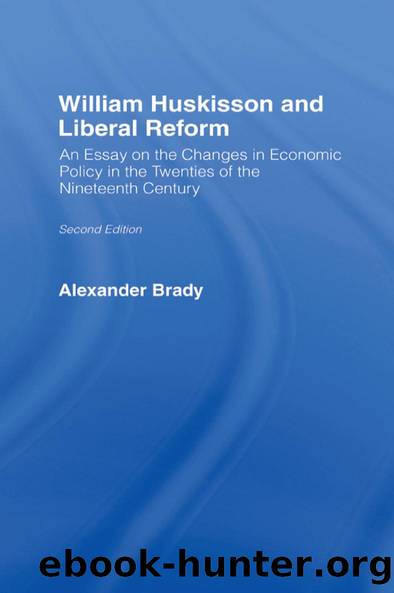William Huskisson and Liberal Reform by Alexander Brady

Author:Alexander Brady [Brady, Alexander]
Language: eng
Format: epub
ISBN: 9780714614564
Barnesnoble:
Publisher: Taylor & Francis
Published: 1967-02-24T00:00:00+00:00
Other evidence strengthened Bowring's general conclusion. Even Brunskill admitted an immense increase in the manufacture of certain silks at Manchester, and a goodly portion of these went to France. Dillon, whose opinion as a warehouseman was valuable, recorded that the purchases of English silk goods since 1826 had considerably increased.2 On one matter Huskisson's hopes remained unfulfilled. Smuggling had not decreased since 1826. J. D. Hume, at this time joint secretary to the Board of Trade and with no axe to grind, stated that since 1830 smuggling had increased. His remedy was the reduction of duties on manufactured silks from 30 per cent, to 25 per cent. which would remove the inducement to smuggle, as most purchasers preferred paying a 25 per cent, duty than buying from the smuggler while the cost of smuggling was 20 per cent.3 Brunskill believed that smuggling had increased, and that the measures of 1824 operated as a license. His remedy, much different from Hume's, was prohibition. Huskisson's duty was either too low or too high. Had he been alive in 1832 he would probably have agreed with Hume.
The six years from 1826 to 1832 might seem an inadequate period to judge the effects of Huskisson's measures. Hence the evidence before the committee on import duties in 1840 has perhaps more weight than that in 1832. Many witnesses, especially Dillon, Hilton, Bowring, and Porter, attested to the steady growth of the industry from 1826 to 1840.1 Porter's evidence was of particular importance, for he was head of the statistical department in the Board of Trade, and his statistics were above reproach. In his Progress of the Nation his figures illustrated the growth of the silk industry over a longer period, and are a more convincing proof than his evidence that Huskisson's measures were justified. Certainly the fears of manufacturers that the industry would be shattered by the changes of 1824 were ill founded. In the ten years preceding 1824 the quantity of raw and thrown silk used by British manufacturers amounted to 18,823,177 lb., or 1,882,311 lb. per annum. In the ten years immediately after that date the quantity used was 36,780,009 lb., or 3,678,001 lb. per annum, being an increase over the average of the former period of 95 per cent. In addition the export of British manufactured silks had increased, such increase being largely in the coarser grades:
Year
Volume of exports
Download
This site does not store any files on its server. We only index and link to content provided by other sites. Please contact the content providers to delete copyright contents if any and email us, we'll remove relevant links or contents immediately.
International Integration of the Brazilian Economy by Elias C. Grivoyannis(98188)
The Radium Girls by Kate Moore(11964)
Turbulence by E. J. Noyes(7977)
Nudge - Improving Decisions about Health, Wealth, and Happiness by Thaler Sunstein(7654)
The Black Swan by Nassim Nicholas Taleb(7053)
Rich Dad Poor Dad by Robert T. Kiyosaki(6502)
Pioneering Portfolio Management by David F. Swensen(6253)
Man-made Catastrophes and Risk Information Concealment by Dmitry Chernov & Didier Sornette(5951)
Zero to One by Peter Thiel(5728)
Secrecy World by Jake Bernstein(4697)
Millionaire: The Philanderer, Gambler, and Duelist Who Invented Modern Finance by Janet Gleeson(4417)
The Age of Surveillance Capitalism by Shoshana Zuboff(4241)
Skin in the Game by Nassim Nicholas Taleb(4200)
Bullshit Jobs by David Graeber(4134)
The Money Culture by Michael Lewis(4126)
Skin in the Game: Hidden Asymmetries in Daily Life by Nassim Nicholas Taleb(3960)
The Dhandho Investor by Mohnish Pabrai(3721)
The Wisdom of Finance by Mihir Desai(3691)
Blockchain Basics by Daniel Drescher(3533)
